Thursday, 2 June 2011: Croix Rousse and early cinema
Written 5 June 2011
Thursday morning, the clouds persisted, but it wasn't actually raining. We had breakfast a little more promptly and started off for our guided tour of the Croix Rousse district (free with our citycards). We got there a little late because I botched up our subway route and sent us off to the east bank of the Rhône, so we had to backtrack. As we emerged from the subway on the heights of the Croix Rousse ("reddish cross") district, we saw the group just leaving the rendezvous point, after the guide's introductory talk, and were able to catch up.
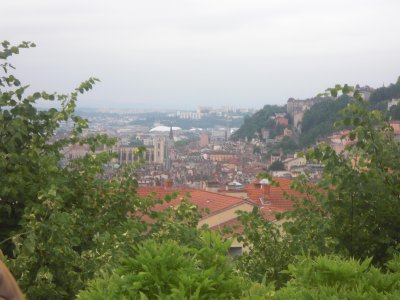
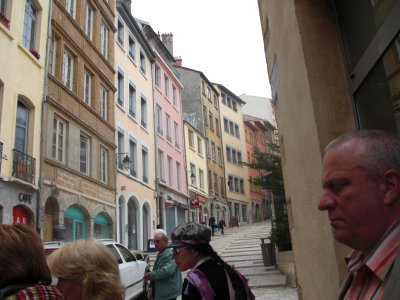 Croix Rousse is between the rivers, directly north of the confluence, on a very high, steep hill. This view is looking back down the hill toward the confluence, which is marked by the large, rounded white roofs (the top of a new entertain and leisure center, still under construction). The hill at the right in the (left-hand) photo is the one with the big basilica and TV/Eiffel tower on top (both just out of the frame to the right). The guide said that Croix Rousse was called "the working hill" and that the other, home not just to the basilica but to several other churches and a number of convents, was called "the praying hill." Croix Rousse is four subway stops north of our hotel; the first two are normal, level runs. The next two, up the slope to the Croix Rousse plateau, are nearly as steeply inclined as a funicular, and even then, leaving the station for the surface takes three escalator rides.
Croix Rousse is between the rivers, directly north of the confluence, on a very high, steep hill. This view is looking back down the hill toward the confluence, which is marked by the large, rounded white roofs (the top of a new entertain and leisure center, still under construction). The hill at the right in the (left-hand) photo is the one with the big basilica and TV/Eiffel tower on top (both just out of the frame to the right). The guide said that Croix Rousse was called "the working hill" and that the other, home not just to the basilica but to several other churches and a number of convents, was called "the praying hill." Croix Rousse is four subway stops north of our hotel; the first two are normal, level runs. The next two, up the slope to the Croix Rousse plateau, are nearly as steeply inclined as a funicular, and even then, leaving the station for the surface takes three escalator rides.
The east-west streets on that slope can be travelled by car, but those that run north-south consist of steep stairways punctuated by short flat stretches where they cross the east-west streets. The street shown above is only mildly sloped, so it has only shallow steps along the sides and a smooth section in the center for bicycles (and presumably as a gutter). The buildings along it are proportioned so that one does not notice, but they reflect the principal reason why the slopes were developed. Lyon had been a silk-weaving center since the time of François I, but when Jacquard invented his revolutionary device, ceilings all over the city were suddenly too low. A standard silkweaving loom stood 2 m tall, but one with a Jacquard attachment, which fit on top of the loom, stood 4 m tall! The result was a building boom on the nearest vacant land—the slopes. The new buildings had 14-foot ceilings on every floor. Our guide pointed out that, if someone looked out at us from one of the the windows in the photo, his head would not reach even the lowest crosspiece of the mullion. Typically, the loom, owned by the individual "canut" (silkweaver), stood just inside the high front window, which admitted natural light for the work, and the back half of the room was divided into two levels, with a loft for sleeping above a kitchen and living area. Whole families lived in these "studio" appartments. Only the top floor would be less tall and would house all the related crafts and occupations—like spinners and people who wound the bobbins for the weavers' shuttles. At the height of the Jacquard handweaving industry, as many as 110,000 canuts worked Jacquard looms in this area. The clacking of the looms pervaded the streets.
Written 6 June 2011
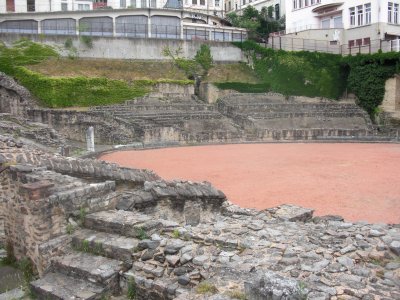 Our guide also took us through many traboules and showed us the ruins of the Roman amphitheater, about a quarter of which is left, shown here. She also taught us the difference between an amphitheater, a theater, and an odeon. A Roman theater was a half circle (or half oval) with a stage at the bottom. The one in Lyon, located behind the Fourvière hill, near the Gallo-Roman museum, sat about 10,000. An Odeum (Odéon in French) was a small half-circle theater used for music, poetry (i.e., ode) readings, and other presentations by individuals. Lyon's, located next to the theater, sat about 3000. An amphitheater, as I should have deduced from the prefix "amphi-," is a double theater, i.e., two half-circles facing one another to form a complete oval, with an arena in the center. Apparently they didn't have enough room on Fourvière hill, so they built it over in Croix Rousse. It now houses a post commemorating the blessing by a visiting pope of the spot where Lyon's (perhaps France's?) first Christian martyr died. She was Sainte Blandine, a teenage girl, and she died on June 2, the very day we were visiting the spot. The guide explained that she was long thought to have died in one location (the Roman theater?) but was later demonstrated to have died in another (the amphitheater?), and I didn't get straight which was which and whether the discovery was made before or after the pope's visit.
Our guide also took us through many traboules and showed us the ruins of the Roman amphitheater, about a quarter of which is left, shown here. She also taught us the difference between an amphitheater, a theater, and an odeon. A Roman theater was a half circle (or half oval) with a stage at the bottom. The one in Lyon, located behind the Fourvière hill, near the Gallo-Roman museum, sat about 10,000. An Odeum (Odéon in French) was a small half-circle theater used for music, poetry (i.e., ode) readings, and other presentations by individuals. Lyon's, located next to the theater, sat about 3000. An amphitheater, as I should have deduced from the prefix "amphi-," is a double theater, i.e., two half-circles facing one another to form a complete oval, with an arena in the center. Apparently they didn't have enough room on Fourvière hill, so they built it over in Croix Rousse. It now houses a post commemorating the blessing by a visiting pope of the spot where Lyon's (perhaps France's?) first Christian martyr died. She was Sainte Blandine, a teenage girl, and she died on June 2, the very day we were visiting the spot. The guide explained that she was long thought to have died in one location (the Roman theater?) but was later demonstrated to have died in another (the amphitheater?), and I didn't get straight which was which and whether the discovery was made before or after the pope's visit.
Croix Rousse was also the cradle of organized labor—the silkweavers organized strikes on two occasions (in the first half of the 19th century), demanding a living wage. The concessions they won were later rescinded, but the idea had been planted. Other features of the tour were a visit to the site where the Claudian tablets were found (Roman Emperor Claude, born in Lyon, delivered an address in which he said he thought all citizens of Lyon should be made citizens of Rome—it didn't happen, but his address was transcribed in its entirety in bronze and posted publicly; part of it is on display in the Gallo-Roman Museum.) and a visit to a monument honoring the inventor of rayon. The guide insisted he also invented nylon, despite being questioned by others on the tour, but our guide on a later tour said nylon was invented in the U.S. and that this guy invented "viscose" and rayon. We walked through a semienclosed sort of renaissance shopping mall that is now a city-run arts incubator (most of the shops were closed, as were a great many of the businesses on neighboring streets, but the guide didn't mention anything about a flight of business from the area). We even saw some of the earliest semi-indoor plumbing in Lyon—little earth closets installed on the landings of the big spiral staircases.
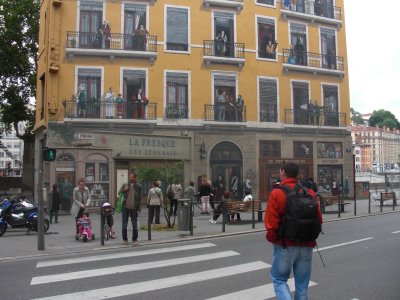
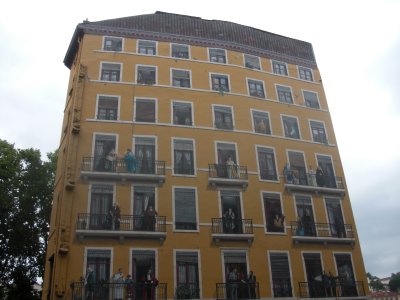 The tour had been cleverly organized so that we started at the top of the hill and worked our way down, so as not to have to climb all those "streets" consisting of stairs. When we finally arrived at the banks of the Saône, the tour ended in front of this magnificent trompe l'oeuil mural, which portrays historical personages of Lyon, from most recent at the bottom to ancient Rome at the top (the city was founded in 43 BC). For example, on the third floor, second window from the left, the little patch of blue is the clothing of Le Petit Prince from the book of the same name, standing next to the author, Antoine de St. Expuéry, in his flying gear. Just below them are the Lumière brothers, inventor of cinema. Let me emphasize that this entire wall is completely flat; everything you see, including the shops at the bottom and the balcony railings, is painted on. The mural continues around the corner to the right, because that whole end of the building is also flat. (The left hand end and the side away from the camera, facing the river, have real windows and doors, and the building is inhabited.
The tour had been cleverly organized so that we started at the top of the hill and worked our way down, so as not to have to climb all those "streets" consisting of stairs. When we finally arrived at the banks of the Saône, the tour ended in front of this magnificent trompe l'oeuil mural, which portrays historical personages of Lyon, from most recent at the bottom to ancient Rome at the top (the city was founded in 43 BC). For example, on the third floor, second window from the left, the little patch of blue is the clothing of Le Petit Prince from the book of the same name, standing next to the author, Antoine de St. Expuéry, in his flying gear. Just below them are the Lumière brothers, inventor of cinema. Let me emphasize that this entire wall is completely flat; everything you see, including the shops at the bottom and the balcony railings, is painted on. The mural continues around the corner to the right, because that whole end of the building is also flat. (The left hand end and the side away from the camera, facing the river, have real windows and doors, and the building is inhabited.
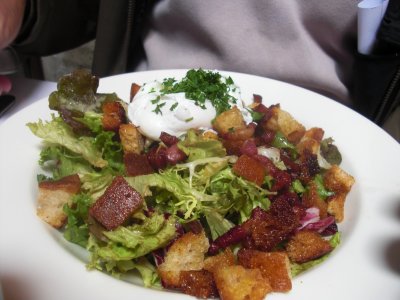
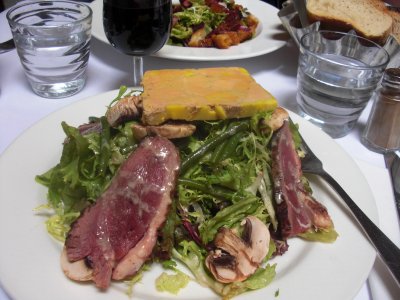 At the end of the tour, we were conveniently close to the rue Mercière, which we knew to be lined with eateries, so we strolled down there and settled at Le Layon, a couple of doors from our restaurant of the night before. David had a salade Lyonnaise (lardons, soft poached egg, and croutons), and I had the salade gourmande (green beans, foie gras, raw mushrooms, and slices of rare grilled duck breast). Note that these are supposed to be appetizers. The French waiters are always surprised when that's all we want for lunch. While we ate at an outdoor table, a strolling magician entertained people at the café across the street, and after he moved on, a little old lady came by, singing for tips. Behind her, she pulled a little shopping trolley loaded with a battery-operated amplifier. She was pretty good but didn't seem to be drawing many tips.
At the end of the tour, we were conveniently close to the rue Mercière, which we knew to be lined with eateries, so we strolled down there and settled at Le Layon, a couple of doors from our restaurant of the night before. David had a salade Lyonnaise (lardons, soft poached egg, and croutons), and I had the salade gourmande (green beans, foie gras, raw mushrooms, and slices of rare grilled duck breast). Note that these are supposed to be appetizers. The French waiters are always surprised when that's all we want for lunch. While we ate at an outdoor table, a strolling magician entertained people at the café across the street, and after he moved on, a little old lady came by, singing for tips. Behind her, she pulled a little shopping trolley loaded with a battery-operated amplifier. She was pretty good but didn't seem to be drawing many tips.
Next, David wanted to visit the museum at the Center for the History of the Resistance and Deportation, over east of the Rhône, which, in addition to its permanent collection, was featuring a temporary exhibition on portrayal of the resistance in comic strips and comic books, so we strolled to the subway, which zoomed us to the Perrache station, where we caught the tramway one stop to the front door of the museum (all free with our citycards). The iron gate to the center's courtyard was unlocked, but to our surprise, the museum was closed up tight! So was the mayor's office, next door, where we went in an attempt to ask why. We rechecked all our literature, all of which assured us that the museum should be open Thursday afternoons. Well, drat. Then it dawned on us: hadn't the school across the street been awfully quiet this morning?, and all those shops in Croix Rousse were closed—the anniversary of Saint Blandine's martrydom is a public holiday in Lyon! Sure enough the museum was open Tuesdays through Sundays except for holidays.
So back to the little tourist leaflet—what museums are open on holidays? Aha, the Lumière Museum, and it's even over on this side of town. We reboarded the tram to continue in the same direction, because up the line a ways, it intersected the metro just one stop from the Lumière mansion. Unfortunately, as we found out from the recorded voice endlessly repeating itself in the tram, service on that tram line was interrupted for construction, and it ended one stop short of the intersection. Rather than take the bus ferrying passengers past the construction zone to the intersection, then catching the metro at right angles to it, we just walked the hypotenuse and arrived promptly at the museum, which was free with our citycards.
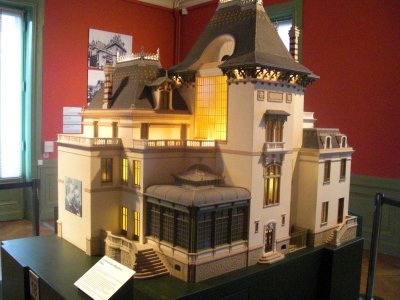
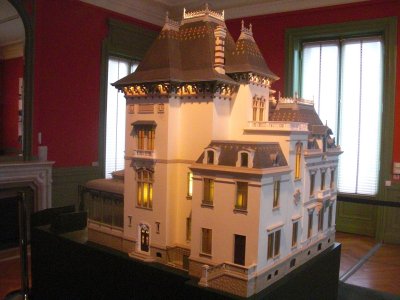 Antoine Lumière made a fortune in the manufacturing of photographic plates, paper, and supplies, which he used to build this wonderful mansion in eastern Lyon. You can't get a good photo of the actual house, because so many trees are in the way, but this scale model, displayed in the museum, is a good substitute (the model was made by Dan Ohlmann, about whom more later). Naturally, everybody in the family was heavily into photography, so the museum contains a wealth of early photographs, of astonishing quality. But the two oldest sons, Auguste and Louis, were determined to perfect the moving picture. One whole room is filled with things that were almost cinematography—Edison's kinetoscope, various rotating drums viewed through slots, etc., but the Lumière brothers were the ones to figure out how to make a camera that would advance the film frame by frame, hold it still long enough to be exposed, then move it quickly out of the way. The original was actually based on sewing-machine technology, which advanced the fabric between stitches but held it firmly in place during each stitch. Throughout the museum, on all kinds of surfaces, from overhead and from behind frosted glass, their films are projected continuously, and the quality is amazing—better than many commercially successful early Hollywood films. The very first film they ever made was of factory workers pouring out the door of Antoine's factory (a couple of blocks from the house) at the end of the work day.
Antoine Lumière made a fortune in the manufacturing of photographic plates, paper, and supplies, which he used to build this wonderful mansion in eastern Lyon. You can't get a good photo of the actual house, because so many trees are in the way, but this scale model, displayed in the museum, is a good substitute (the model was made by Dan Ohlmann, about whom more later). Naturally, everybody in the family was heavily into photography, so the museum contains a wealth of early photographs, of astonishing quality. But the two oldest sons, Auguste and Louis, were determined to perfect the moving picture. One whole room is filled with things that were almost cinematography—Edison's kinetoscope, various rotating drums viewed through slots, etc., but the Lumière brothers were the ones to figure out how to make a camera that would advance the film frame by frame, hold it still long enough to be exposed, then move it quickly out of the way. The original was actually based on sewing-machine technology, which advanced the fabric between stitches but held it firmly in place during each stitch. Throughout the museum, on all kinds of surfaces, from overhead and from behind frosted glass, their films are projected continuously, and the quality is amazing—better than many commercially successful early Hollywood films. The very first film they ever made was of factory workers pouring out the door of Antoine's factory (a couple of blocks from the house) at the end of the work day.
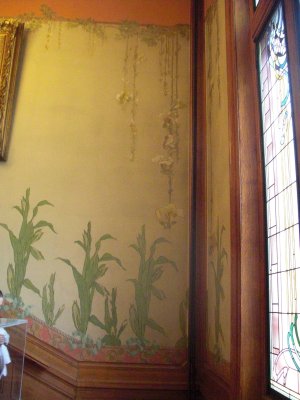
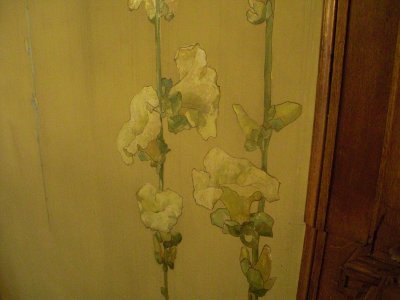 The house itself is beautiful. Here are photos of the art nouveau decor of the grand staircase. The one on the right is a close-up of the flowers trailing downward toward the stalks of corn (I don't know why corn). The newel post of the staircase is a five-foot carved wooden rooster. The staircas is lit by a huge rectangular stained-glass window (viewed edge-on in the left-hand photo), which is visible in the views of the model house (but without the stained glass). Where the walls meet the ceiling are a series of ceramic peacocks with lights installed in their tails.
The house itself is beautiful. Here are photos of the art nouveau decor of the grand staircase. The one on the right is a close-up of the flowers trailing downward toward the stalks of corn (I don't know why corn). The newel post of the staircase is a five-foot carved wooden rooster. The staircas is lit by a huge rectangular stained-glass window (viewed edge-on in the left-hand photo), which is visible in the views of the model house (but without the stained glass). Where the walls meet the ceiling are a series of ceramic peacocks with lights installed in their tails.
Finally, the museum displays a genealogy of the Lumière family that I found startling. Antoine and his wife had six children, one of whom died young. Of the remaining five, three—August, Louis, and their sister France— married people named Winckler. One of France's daughters married a guy named Lumière! Talk about a couple of close families!
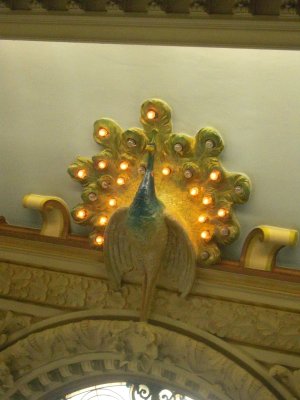 Dinner was at Brasserie Georges—"Bonne bière et bonne chère depuis 1836"—a true institution, beloved of all the Lyonnais. I'll have to look up "chère"; surely the slogan doesn't mean "Good beer and really expensive since 1836," as it looks as though it might. "Chère" must mean "value" or "fellowship" or "cheer" or "portion size" or some such. [Note added later: "bonne chère" has evolved through several meanings, the two most recent of which are "hearty welcome" (up to the 17th century) and "good and hearty food" (since then).] On a Thursday evening, it was spinning off the map—a big (art nouveau) barn of a room (but with art deco chandeliers) filled with happy, festive Lyonnais. The menu makes a point of the number of prices that have been lowered recently. The French government recently lowered the value-added tax, and opponents of the measure must have claimed that merchants would simply keep their prices the same and pocket the difference, because all the restaurants on this trip list, right on their menus, the price reductions they've made—they must be required to do so to demonstrate that they're passing the savings along.
Dinner was at Brasserie Georges—"Bonne bière et bonne chère depuis 1836"—a true institution, beloved of all the Lyonnais. I'll have to look up "chère"; surely the slogan doesn't mean "Good beer and really expensive since 1836," as it looks as though it might. "Chère" must mean "value" or "fellowship" or "cheer" or "portion size" or some such. [Note added later: "bonne chère" has evolved through several meanings, the two most recent of which are "hearty welcome" (up to the 17th century) and "good and hearty food" (since then).] On a Thursday evening, it was spinning off the map—a big (art nouveau) barn of a room (but with art deco chandeliers) filled with happy, festive Lyonnais. The menu makes a point of the number of prices that have been lowered recently. The French government recently lowered the value-added tax, and opponents of the measure must have claimed that merchants would simply keep their prices the same and pocket the difference, because all the restaurants on this trip list, right on their menus, the price reductions they've made—they must be required to do so to demonstrate that they're passing the savings along.
No fewer than four times in the course of our dinner, the lights were dimmed, the (recorded) organ struck up "Happy Birthday," a waiter paraded across the room carrying a dessert with a sparkler stuck in it, and the whole room applauded. Three of the four sparkling desserts were baked Alaska (or "omelette norvégienne." Norwegian omelet, as the French call it), apparently a particularly festive dessert around here. At first I was puzzled as to why a traditional brasserie should feature baked Alaska—it seems kind of new-fangled for the place—until I thought about the number of servings of beef tartare that place moves in a night. We probably saw 50 of them prepared at tableside in the time we were there, and every single one was topped with a raw egg yolk. That's a lot of egg whites to use up!
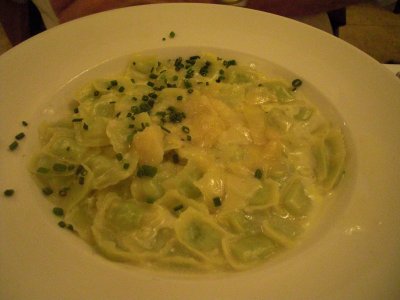
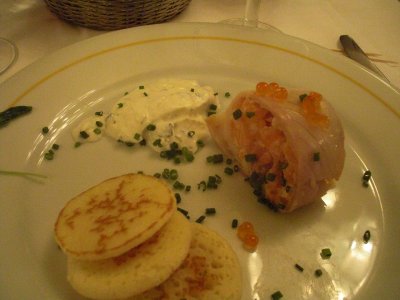 First course, David: Tiny Lyonnais ravioli, with chive filling—about a million of them dressed with butter and herbs and topped with a little melted cheese. Very tasty.
First course, David: Tiny Lyonnais ravioli, with chive filling—about a million of them dressed with butter and herbs and topped with a little melted cheese. Very tasty.
First course, me: Salmon tartare with a mild creamy dressing, wrapped in a slice of smoked sturgeon and decorated with salmon caviare (delicious). On the side, a sauce of fromage blanc with chives (good) and three small blini (stale, pastey, and icky).
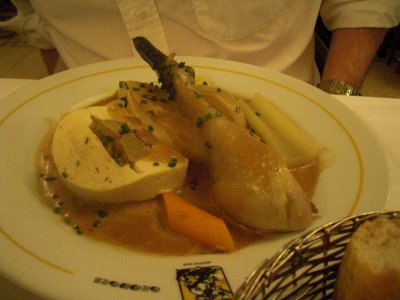
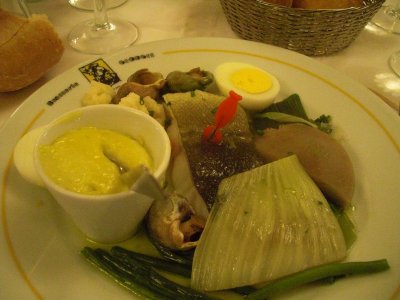 Main course, David: Bresse chicken, with part of the foot still attached to the drumstick, so that we could be sure it was authenically blue. The breast was stuffed with foie gras. On the side, vegetables stewed with the chicken leg. As usual, we didn't find it anything special.
Main course, David: Bresse chicken, with part of the foot still attached to the drumstick, so that we could be sure it was authenically blue. The breast was stuffed with foie gras. On the side, vegetables stewed with the chicken leg. As usual, we didn't find it anything special.
Main course, me: "Grand aioli de cabillaud." In the center a skin-on slab of fresh poached cod ("cabillaud"). Around it, clockwise from about 11 o'clock, steamed cauliflower, two "bulots" (small boiled whelks), half a boiled egg, a 4-inch chunk of dark-green poached leek top with half a cooked artichoke bottom on top of it, a chunk of poached fennel, some excellent tender-crisp green beans, another bulot, and a tall white pot of fiercely garlicky "aioli" (garlic mayo), which hides the other half of the boiled egg. You put the aioli on all the other stuff. The red object stabbed into the cod is a stout pin, to be used to pry the bulots from their shells. All delicious.
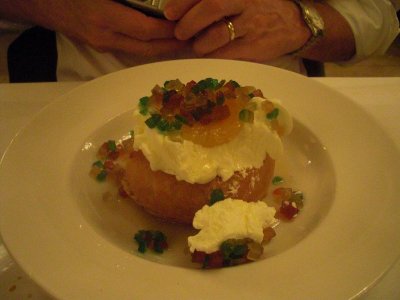
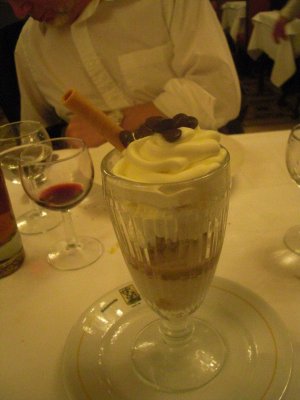 Dessert, David: Baba au rhum, topped with whipped cream and made gaudy with a drift of diced glacéed fruit. The baba had, of course, already been soaked in a rum-flavored syrup, but the waiter brought the bottle of rum to the table, dumped about 4 oz of it over the baba, then left the bottle in case David wanted to add more. The baba was a routine baba au rhum (if slightly more alcoholic than some), but the diced fruit was outstanding.
Dessert, David: Baba au rhum, topped with whipped cream and made gaudy with a drift of diced glacéed fruit. The baba had, of course, already been soaked in a rum-flavored syrup, but the waiter brought the bottle of rum to the table, dumped about 4 oz of it over the baba, then left the bottle in case David wanted to add more. The baba was a routine baba au rhum (if slightly more alcoholic than some), but the diced fruit was outstanding.
Dessert, me: a café liègeois of no great distinction, topped with coffee-bean shaped chocolate candies.
previous entry
List of Entries
next entry

 Croix Rousse is between the rivers, directly north of the confluence, on a very high, steep hill. This view is looking back down the hill toward the confluence, which is marked by the large, rounded white roofs (the top of a new entertain and leisure center, still under construction). The hill at the right in the (left-hand) photo is the one with the big basilica and TV/Eiffel tower on top (both just out of the frame to the right). The guide said that Croix Rousse was called "the working hill" and that the other, home not just to the basilica but to several other churches and a number of convents, was called "the praying hill." Croix Rousse is four subway stops north of our hotel; the first two are normal, level runs. The next two, up the slope to the Croix Rousse plateau, are nearly as steeply inclined as a funicular, and even then, leaving the station for the surface takes three escalator rides.
Croix Rousse is between the rivers, directly north of the confluence, on a very high, steep hill. This view is looking back down the hill toward the confluence, which is marked by the large, rounded white roofs (the top of a new entertain and leisure center, still under construction). The hill at the right in the (left-hand) photo is the one with the big basilica and TV/Eiffel tower on top (both just out of the frame to the right). The guide said that Croix Rousse was called "the working hill" and that the other, home not just to the basilica but to several other churches and a number of convents, was called "the praying hill." Croix Rousse is four subway stops north of our hotel; the first two are normal, level runs. The next two, up the slope to the Croix Rousse plateau, are nearly as steeply inclined as a funicular, and even then, leaving the station for the surface takes three escalator rides.  Our guide also took us through many traboules and showed us the ruins of the Roman amphitheater, about a quarter of which is left, shown here. She also taught us the difference between an amphitheater, a theater, and an odeon. A Roman theater was a half circle (or half oval) with a stage at the bottom. The one in Lyon, located behind the Fourvière hill, near the Gallo-Roman museum, sat about 10,000. An Odeum (Odéon in French) was a small half-circle theater used for music, poetry (i.e., ode) readings, and other presentations by individuals. Lyon's, located next to the theater, sat about 3000. An amphitheater, as I should have deduced from the prefix "amphi-," is a double theater, i.e., two half-circles facing one another to form a complete oval, with an arena in the center. Apparently they didn't have enough room on Fourvière hill, so they built it over in Croix Rousse. It now houses a post commemorating the blessing by a visiting pope of the spot where Lyon's (perhaps France's?) first Christian martyr died. She was Sainte Blandine, a teenage girl, and she died on June 2, the very day we were visiting the spot. The guide explained that she was long thought to have died in one location (the Roman theater?) but was later demonstrated to have died in another (the amphitheater?), and I didn't get straight which was which and whether the discovery was made before or after the pope's visit.
Our guide also took us through many traboules and showed us the ruins of the Roman amphitheater, about a quarter of which is left, shown here. She also taught us the difference between an amphitheater, a theater, and an odeon. A Roman theater was a half circle (or half oval) with a stage at the bottom. The one in Lyon, located behind the Fourvière hill, near the Gallo-Roman museum, sat about 10,000. An Odeum (Odéon in French) was a small half-circle theater used for music, poetry (i.e., ode) readings, and other presentations by individuals. Lyon's, located next to the theater, sat about 3000. An amphitheater, as I should have deduced from the prefix "amphi-," is a double theater, i.e., two half-circles facing one another to form a complete oval, with an arena in the center. Apparently they didn't have enough room on Fourvière hill, so they built it over in Croix Rousse. It now houses a post commemorating the blessing by a visiting pope of the spot where Lyon's (perhaps France's?) first Christian martyr died. She was Sainte Blandine, a teenage girl, and she died on June 2, the very day we were visiting the spot. The guide explained that she was long thought to have died in one location (the Roman theater?) but was later demonstrated to have died in another (the amphitheater?), and I didn't get straight which was which and whether the discovery was made before or after the pope's visit.
 The tour had been cleverly organized so that we started at the top of the hill and worked our way down, so as not to have to climb all those "streets" consisting of stairs. When we finally arrived at the banks of the Saône, the tour ended in front of this magnificent trompe l'oeuil mural, which portrays historical personages of Lyon, from most recent at the bottom to ancient Rome at the top (the city was founded in 43 BC). For example, on the third floor, second window from the left, the little patch of blue is the clothing of Le Petit Prince from the book of the same name, standing next to the author, Antoine de St. Expuéry, in his flying gear. Just below them are the Lumière brothers, inventor of cinema. Let me emphasize that this entire wall is completely flat; everything you see, including the shops at the bottom and the balcony railings, is painted on. The mural continues around the corner to the right, because that whole end of the building is also flat. (The left hand end and the side away from the camera, facing the river, have real windows and doors, and the building is inhabited.
The tour had been cleverly organized so that we started at the top of the hill and worked our way down, so as not to have to climb all those "streets" consisting of stairs. When we finally arrived at the banks of the Saône, the tour ended in front of this magnificent trompe l'oeuil mural, which portrays historical personages of Lyon, from most recent at the bottom to ancient Rome at the top (the city was founded in 43 BC). For example, on the third floor, second window from the left, the little patch of blue is the clothing of Le Petit Prince from the book of the same name, standing next to the author, Antoine de St. Expuéry, in his flying gear. Just below them are the Lumière brothers, inventor of cinema. Let me emphasize that this entire wall is completely flat; everything you see, including the shops at the bottom and the balcony railings, is painted on. The mural continues around the corner to the right, because that whole end of the building is also flat. (The left hand end and the side away from the camera, facing the river, have real windows and doors, and the building is inhabited.
 At the end of the tour, we were conveniently close to the rue Mercière, which we knew to be lined with eateries, so we strolled down there and settled at Le Layon, a couple of doors from our restaurant of the night before. David had a salade Lyonnaise (lardons, soft poached egg, and croutons), and I had the salade gourmande (green beans, foie gras, raw mushrooms, and slices of rare grilled duck breast). Note that these are supposed to be appetizers. The French waiters are always surprised when that's all we want for lunch. While we ate at an outdoor table, a strolling magician entertained people at the café across the street, and after he moved on, a little old lady came by, singing for tips. Behind her, she pulled a little shopping trolley loaded with a battery-operated amplifier. She was pretty good but didn't seem to be drawing many tips.
At the end of the tour, we were conveniently close to the rue Mercière, which we knew to be lined with eateries, so we strolled down there and settled at Le Layon, a couple of doors from our restaurant of the night before. David had a salade Lyonnaise (lardons, soft poached egg, and croutons), and I had the salade gourmande (green beans, foie gras, raw mushrooms, and slices of rare grilled duck breast). Note that these are supposed to be appetizers. The French waiters are always surprised when that's all we want for lunch. While we ate at an outdoor table, a strolling magician entertained people at the café across the street, and after he moved on, a little old lady came by, singing for tips. Behind her, she pulled a little shopping trolley loaded with a battery-operated amplifier. She was pretty good but didn't seem to be drawing many tips.
 Antoine Lumière made a fortune in the manufacturing of photographic plates, paper, and supplies, which he used to build this wonderful mansion in eastern Lyon. You can't get a good photo of the actual house, because so many trees are in the way, but this scale model, displayed in the museum, is a good substitute (the model was made by Dan Ohlmann, about whom more later). Naturally, everybody in the family was heavily into photography, so the museum contains a wealth of early photographs, of astonishing quality. But the two oldest sons, Auguste and Louis, were determined to perfect the moving picture. One whole room is filled with things that were almost cinematography—Edison's kinetoscope, various rotating drums viewed through slots, etc., but the Lumière brothers were the ones to figure out how to make a camera that would advance the film frame by frame, hold it still long enough to be exposed, then move it quickly out of the way. The original was actually based on sewing-machine technology, which advanced the fabric between stitches but held it firmly in place during each stitch. Throughout the museum, on all kinds of surfaces, from overhead and from behind frosted glass, their films are projected continuously, and the quality is amazing—better than many commercially successful early Hollywood films. The very first film they ever made was of factory workers pouring out the door of Antoine's factory (a couple of blocks from the house) at the end of the work day.
Antoine Lumière made a fortune in the manufacturing of photographic plates, paper, and supplies, which he used to build this wonderful mansion in eastern Lyon. You can't get a good photo of the actual house, because so many trees are in the way, but this scale model, displayed in the museum, is a good substitute (the model was made by Dan Ohlmann, about whom more later). Naturally, everybody in the family was heavily into photography, so the museum contains a wealth of early photographs, of astonishing quality. But the two oldest sons, Auguste and Louis, were determined to perfect the moving picture. One whole room is filled with things that were almost cinematography—Edison's kinetoscope, various rotating drums viewed through slots, etc., but the Lumière brothers were the ones to figure out how to make a camera that would advance the film frame by frame, hold it still long enough to be exposed, then move it quickly out of the way. The original was actually based on sewing-machine technology, which advanced the fabric between stitches but held it firmly in place during each stitch. Throughout the museum, on all kinds of surfaces, from overhead and from behind frosted glass, their films are projected continuously, and the quality is amazing—better than many commercially successful early Hollywood films. The very first film they ever made was of factory workers pouring out the door of Antoine's factory (a couple of blocks from the house) at the end of the work day.
 The house itself is beautiful. Here are photos of the art nouveau decor of the grand staircase. The one on the right is a close-up of the flowers trailing downward toward the stalks of corn (I don't know why corn). The newel post of the staircase is a five-foot carved wooden rooster. The staircas is lit by a huge rectangular stained-glass window (viewed edge-on in the left-hand photo), which is visible in the views of the model house (but without the stained glass). Where the walls meet the ceiling are a series of ceramic peacocks with lights installed in their tails.
The house itself is beautiful. Here are photos of the art nouveau decor of the grand staircase. The one on the right is a close-up of the flowers trailing downward toward the stalks of corn (I don't know why corn). The newel post of the staircase is a five-foot carved wooden rooster. The staircas is lit by a huge rectangular stained-glass window (viewed edge-on in the left-hand photo), which is visible in the views of the model house (but without the stained glass). Where the walls meet the ceiling are a series of ceramic peacocks with lights installed in their tails.  Dinner was at Brasserie Georges—"Bonne bière et bonne chère depuis 1836"—a true institution, beloved of all the Lyonnais. I'll have to look up "chère"; surely the slogan doesn't mean "Good beer and really expensive since 1836," as it looks as though it might. "Chère" must mean "value" or "fellowship" or "cheer" or "portion size" or some such. [Note added later: "bonne chère" has evolved through several meanings, the two most recent of which are "hearty welcome" (up to the 17th century) and "good and hearty food" (since then).] On a Thursday evening, it was spinning off the map—a big (art nouveau) barn of a room (but with art deco chandeliers) filled with happy, festive Lyonnais. The menu makes a point of the number of prices that have been lowered recently. The French government recently lowered the value-added tax, and opponents of the measure must have claimed that merchants would simply keep their prices the same and pocket the difference, because all the restaurants on this trip list, right on their menus, the price reductions they've made—they must be required to do so to demonstrate that they're passing the savings along.
Dinner was at Brasserie Georges—"Bonne bière et bonne chère depuis 1836"—a true institution, beloved of all the Lyonnais. I'll have to look up "chère"; surely the slogan doesn't mean "Good beer and really expensive since 1836," as it looks as though it might. "Chère" must mean "value" or "fellowship" or "cheer" or "portion size" or some such. [Note added later: "bonne chère" has evolved through several meanings, the two most recent of which are "hearty welcome" (up to the 17th century) and "good and hearty food" (since then).] On a Thursday evening, it was spinning off the map—a big (art nouveau) barn of a room (but with art deco chandeliers) filled with happy, festive Lyonnais. The menu makes a point of the number of prices that have been lowered recently. The French government recently lowered the value-added tax, and opponents of the measure must have claimed that merchants would simply keep their prices the same and pocket the difference, because all the restaurants on this trip list, right on their menus, the price reductions they've made—they must be required to do so to demonstrate that they're passing the savings along.
 First course, David: Tiny Lyonnais ravioli, with chive filling—about a million of them dressed with butter and herbs and topped with a little melted cheese. Very tasty.
First course, David: Tiny Lyonnais ravioli, with chive filling—about a million of them dressed with butter and herbs and topped with a little melted cheese. Very tasty.
 Main course, David: Bresse chicken, with part of the foot still attached to the drumstick, so that we could be sure it was authenically blue. The breast was stuffed with foie gras. On the side, vegetables stewed with the chicken leg. As usual, we didn't find it anything special.
Main course, David: Bresse chicken, with part of the foot still attached to the drumstick, so that we could be sure it was authenically blue. The breast was stuffed with foie gras. On the side, vegetables stewed with the chicken leg. As usual, we didn't find it anything special.
 Dessert, David: Baba au rhum, topped with whipped cream and made gaudy with a drift of diced glacéed fruit. The baba had, of course, already been soaked in a rum-flavored syrup, but the waiter brought the bottle of rum to the table, dumped about 4 oz of it over the baba, then left the bottle in case David wanted to add more. The baba was a routine baba au rhum (if slightly more alcoholic than some), but the diced fruit was outstanding.
Dessert, David: Baba au rhum, topped with whipped cream and made gaudy with a drift of diced glacéed fruit. The baba had, of course, already been soaked in a rum-flavored syrup, but the waiter brought the bottle of rum to the table, dumped about 4 oz of it over the baba, then left the bottle in case David wanted to add more. The baba was a routine baba au rhum (if slightly more alcoholic than some), but the diced fruit was outstanding.